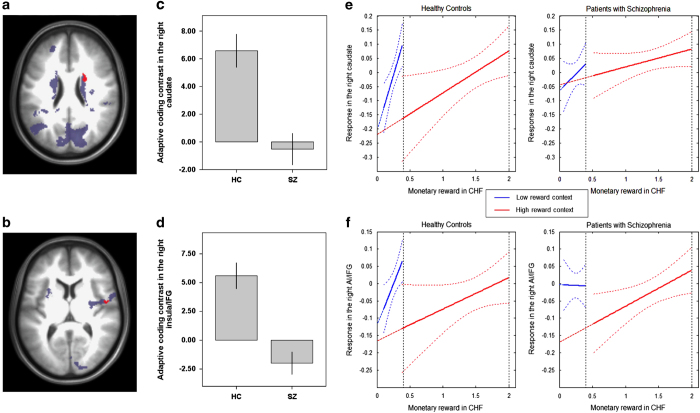Figure 2.
Reward-sensitive regions showing group differences in adaptive coding. Brain regions responding to reward amount and showing differential adaptive coding. Reward responses ((pmod low reward)+(pmod high reward)) are displayed in blue. In red are clusters, where healthy controls showed significantly stronger activation increases in the adaptive coding contrast ((pmod low reward)−(pmod high reward)). Brain images thresholded at P<0.05 (FWE). (a) Axial image of the right caudate. (b) Axial image of the right insula/IFG. Columns in bar graphs illustrate red clusters and reflect adaptive coding contrast estimates ((pmod low reward)−(pmod high reward)) for each group separately (c,d). Response functions of the neural adaptation in the right caudate (e) and the right anterior insula/inferior frontal gyrus (f) plotted separately for the low-reward (blue) and the high-reward (red) context. For visualization purposes, each reward context was divided in two mean reward levels (low reward=CHF 0–0.2, CHF 0.2–0.4; high reward=CHF 0–1, CHF 1–2), which is represented by the x axis. The y axis represents the adaptive coding contrast estimates ((pmod low reward)−(pmod high reward)). Healthy controls optimally adapt the coding range to the current range of rewards in both regions, resulting in a steeper slope of neural responses in the low-reward context than in the high-reward context (e,f; left). In contrast, patients with schizophrenia show significant deficits in adaptive coding, with insufficient slope increase (caudate; e, right) or even shallower slope (insula; f, right) for the low-reward context compared with the high-reward context. The diminished steepness of slopes translates to reduced discriminability in both reward contexts for the right caudate of patients. By contrast, in the right AI/IFG, discriminability was reduced primarily in the low-reward context, whereas it was comparable to the discriminability of healthy controls in the high-reward context. AI, anterior insula; FWE, family-wise error; IFG, inferior frontal gyrus; pmod, parametrically modulated.

